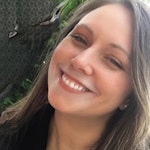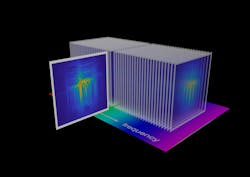Holography and holograms have long been used in documents such as bank notes and passports, and even demonstrated in movies—Star Wars is a great example. But while this method for 3D imaging and displays (among other applications) remains powerful, there is room for improvement.
A new technique—hyperspectral digital holography, developed by a team at the Max Planck Institute of Quantum Optics (MPQ; Garching, Germany)—is advancing and enriching conventional holography with optical frequency combs. Their work presents a combination of features that were presently unavailable for holography.
Laser Focus World spoke with Dr. Nathalie Picqué, a scientist at MPQ whose group led the study, about this new technique and the novel advances it is prompting.
Laser Focus World: What was involved with your research in developing this new technique?
Dr. Nathalie Picqué: Our group at the Max Planck Institute of Quantum Optics has been exploring new approaches to interferometry with frequency combs for more than 15 years. A frequency comb is a spectrum made of evenly spaced phase coherent laser lines. We have been very involved in developing dual-comb interferometry, where one records the time-domain interference between two frequency combs of slightly different repetition frequencies. Dual-comb interferometry has been mostly exploited in the form of dual-comb spectroscopy, a technique of Fourier transform spectroscopy (also known as FTIR) without moving parts.
Spectra can be measured over a broad spectral bandwidth with high accuracy and resolution and short measurement times. In dual-comb spectroscopy, the interference is detected on a single photodetector. With the idea of extending the technique toward hyperspectral imaging, where the single photodetector is replaced by a camera sensor, one gets as many spectra as there are detector pixels and this is powerful for spectroscopically characterizing samples which are spatially inhomogeneous.
Once we had the setup operating for hyperspectral imaging, I realized that we might get much more from the same setup, because the layout was reminiscent of digital holography. So, we just tried to implement holography with our frequency combs and it worked very well. Then, we combined the holography with the hyperspectral gas sensing and it worked just as well.
LFW: How does this new imaging technique differ from existing holography methods?
Picqué: We simultaneously record many holograms (one per comb line). We experimentally demonstrate 100, but it can potentially be several tens of thousands. This is done with a set-up which is not bigger than a traditional digital holography setup and there are ideas to miniaturize this further. Usually in digital holography, a monochromatic laser source (sometime two or three) is used, so that one gets one hologram at a time.
Getting more into details, our technique presents a combination of features that were presently unavailable for holography: use of light sources of broad spectral span but of long temporal coherence, recording technique where all the signal is simultaneously measured.
LFW: What does this new technique accomplish that existing methods cannot?
Picqué: There are several advantages in recording many holograms simultaneously.
One is that with a single hologram at a single color (optical frequency), only the last digits of the distance measurements are known—for instance, you cannot say if your distance is 0.00000010 meters or 15.00000010 meters—whereas with many frequencies, you can lift this ambiguity. As the spacing between the comb lines is usually on the order of 100 MHz, the technique is even suitable for fairly large objects (100 MHz corresponds to ambiguity ranges of 3 meters).
Of course, one can use a tunable laser and measure different frequencies at different times in a sequential manner (and this has been demonstrated by others in the past), but one may add errors if the scene changes during the sequence. Measuring all frequencies at once is going to improve the precision of the measurements. It makes it possible also to add time resolution: if the scene changes over a time scale slower than the measurement time, one could measure dynamic scenes that show a time evolution.
Also, using simultaneously many frequencies means that several optical diagnostics can be simultaneously performed. In our [study], we show that one can combine holography with hyperspectral gas sensing, with a single setup and a single measurement. This is a 4D diagnostic (3D spatial and 1D spectral).
Finally, the laser sources that we use are frequency comb generators. Not only are many narrow laser lines simultaneously emitted, but the absolute frequency of each of these lines can be known within the accuracy of an atomic clock. Perhaps this will enable it to enhance the accuracy of holography.
In summary, we hope to bring to holography new potentialities by improving its capabilities for frequency multiplexing, its accuracy, its precision, its speed, and its ambiguity range.
LFW: What challenges does this new technique overcome?
Picqué: By enabling the simultaneous measurements of many holograms, which was previously not possible, the new technique opens up some intriguing prospects for metrology of 3D objects and for performing several complementary optical diagnostics with a single apparatus.
LFW: For what applications is this technique best suited?
Picqué: Precise wavefront sensing and three-dimensional metrology (optical contouring and deformation measurements, 3D profiling) are obvious applications. This is, for instance, very important for characterizing precisely machined objects, such as optical components especially for the UV, or nanofabricated objects from lithography.
Holography is also widely used in microscopy, in particular for life science applications. We are wondering if frequency combs could bring something to this field and this is something we are willing to explore.
LFW: What do you anticipate for the future of this technology and method?
Picqué: We have performed a successful proof-of-principle demonstration of a new concept. We are currently developing a dedicated system, with a fast camera, and we are exploring more quantitatively the limits of our technique. We hope to further improve our technology.
In the near future, we should see a dramatic increase in the number of comb lines, of the span, and a significant improvement of the measurement speed and the spatial resolution. The success of the new technology will strongly depend on how far we will be able to push the technique. We hope to bring new tools for precise 3D phase imaging that will have a significant impact in various fields of science and technology. If the technique is really worth it, it will open up applications that we cannot foresee today.

Justine Murphy | Multimedia Director, Digital Infrastructure
Justine Murphy is the multimedia director for Endeavor Business Media's Digital Infrastructure Group. She is a multiple award-winning writer and editor with more 20 years of experience in newspaper publishing as well as public relations, marketing, and communications. For nearly 10 years, she has covered all facets of the optics and photonics industry as an editor, writer, web news anchor, and podcast host for an internationally reaching magazine publishing company. Her work has earned accolades from the New England Press Association as well as the SIIA/Jesse H. Neal Awards. She received a B.A. from the Massachusetts College of Liberal Arts.
Nathalie Picqué | Scientist, Max Planck Institute for Quantum Optics (MPQ)
Dr. Nathalie Picqué is a scientist at the Max Planck Institute of Quantum Optics (MPQ; Garching, Germany).
